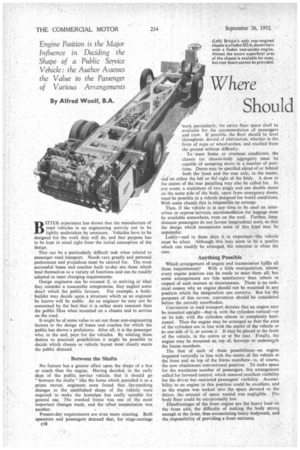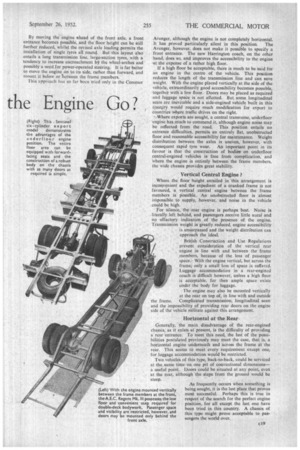Where Should the Engine Go?
Page 84

Page 85

If you've noticed an error in this article please click here to report it so we can fix it.
Engine Position is the Major Influence in Deciding the Shape of a Public Service Vehicle: the Author Assesses the Value to the Passenger of Various Arrangements
By Alfred Woolf, B.A.
BITTER experience has shown that the manufacture of road vehicles is an engineering activity not to be
. lightly undertaken by amateurs. Vehicles have to be designed for the work they will do, and that purpose has to be kept in mind right from the initial conception of the design.
This can be a particularly difficult task when related to passenger road transport. Needs vary greatly and personal preferences and prejudices must be catered for. The most successful buses and coaches built to-day are those which lend themselves to a variety of functions and can be readily adapted to meet changing requirements, Design engineers can be excused if, in.arriving at what they consider a reasonable compromise, they neglect some detail which the public favours. For example, a bodybuilder may decide upon a structure which as an engineer he knows will be stable. As an engineer he may not be concerned by the fact that it is rather more resonant than the public likes when mounted on a chassis and in service on the road.
It might be of some value to set out those non-engineering factors in the design of buses and coaches for which the public has shown a preference. After all, it is the passenger who, in the end, pays for the vehicles. By relating these desires to practical possibilities it might be possible to decide which chassis or vehicle layout most closely meets the public demand.
Between the Shafts
No feature has a greater effect upon the shape of a bus or coach than the engine. Having decided, in the early days of the public service vehicle, that it should go " between the shafts" like the horse which preceded it as a prime mover, engineers soon found that far-reaching changes in the established shape of the vehicle were required to make the horseless bus really suitable for general use. The cranked frame was one of the most important changes made, and the offset transmission was another. • Present-day requirements are even more exacting. Both operators and passengers demand that, for stage-carriage c18
work parncularly, the entire floor space shall be available for the accommodation of passengers and crew. If possible, the floor should be level throughout, devoid of obstruction, whether in the form of steps or wheel-arches, and reached from the ground without difficulty.
To meet home or overseas conditions, the chassis (or. chassis-body aggregate) must be capable of accepting doors in a number of positions. Doors may be specified ahead of or behind both the front and the rear axle, inthe centre. a-ncron either the left or thdr right of the body. A door in the centre of the rear panelling may also be called for. In
• any event, a maximum of two single and one double doors on the same side of the body, apart from emergency doors, must be possible in a vehicle designed for world conditions. With some chassis this is itimossibinto.arrange, Then, if the vehicle is at any. time to be used on interurban or express services, accommodation for luggage must be available somewhere, even on the roof. Further, longdistance passengers do not favour longitudinal seats, so that the design which necessitates seats of this kind may be unpopular. Lastly—and in these days it is important—the vehicle must be silent. Although this may seem to be a quality which can readily be arranged, the converse is often the case.
Anything Possible
Which arrangement of engine and transmission fulfils all
these requirements? With a little manipulation, almost every engine position can be made to meet them all, but sorne arrangements are -less satisfactory than others in respect of such matters as maintenance. There is no technical reason why an engine should not be mounted in any position which the imagination can contrive.But for the purposes of this review, convention should be considered before the entirely unorthodox.
Convention in road transport dictates that an engine may be mounted upright—that is, with the cylinders vertical—or on its side, with the cylinders almost or completely horizontal. Then the engine may be arranged so that the axes of the cylinders are in line with the centre of the vehicle or Lo one side of it, or across it. It may be placed at the front of the vehicle, in the centre or at the rear. Finally, the engine may be mounted on top of, between or underneath the frame members.
The first of each of these possibilities—an engine mounted vertically in line with the centre of the vehicle at the front and on top of the frame members--is, of course, the now obsolescent conventional.position. To make space for the maximum number of passengers, this arrangement called for forward control, which ensured excellent visibility for the driver but restricted passengers' visibility. Accessibility to an engine in this position could be excellent, and as the engine was tucked into the space devoted to the driver, the amount of space wasted was negligible. • The body floor could be exceptionally low. Disadvantages of the front engine are the heavy load on the front axle, the difficulty of making the body strong enough at the front, thus necessitating heavy bodywork, and the, impossibility of providing a front entrance. By moving the engine ahead of the front axle, a front entrance becomes possible, and the floor height can be still further reduced, whilst the revised axle loading permits the installation of single tyres all round. But this layout also entails a long transmission line, large-section tyres, with a tendency to increase encroachment bSt the wheel-arches and possibly a need for power-operated steering. It is far better to move the engine on to its side, rather than forward, and mount it below or tetween the frame members.
This approach has so far been tried only in the Commer
Avenger, although the engine is not completely horizontal.
It has proved particularly silent in this position. The Avenger, however, does not make it possible to specify a front entrance. The new Harrington coach, on the other hand, does so, and improves the accessibility to the engine at the expense of a rather high floor.
If a high floor be acceptable, there is much to be said for an engine in the centre of the vehicle. This position reduces the length of the transmission line and can save weight. With the engine placed vertically at the side of the vehicle, extraordinarily good accessibility becomes possible, together with a tow floor. Doors may be placed as required and luggage space is not affeeted. But some longitudinal seats are inevitable and a side-engined vehicle built in this coun,try would require much modification for export to countries where traffic drives on the right.
Where exports are sought, a central transverse, underfloor engine has much to commend it, although engine noise may be reflected from the road. 'This position entails no entrance difficulties, permits an entirely flat, unobstructed floor and reasonable accessibility for maintenance. Weight distribution between the axles is uneven, however, with consequent rapid tyre wear. An important point in its favour is that the construction of bodies on underfloor central-engined vehicles is free from complication, and where the engine is entirely between the frame members, the wide chassis provides great stability.
Vertical Central Engine ?
Where the floor height entailed in this arrangement is inconvenient and the expedient of a cranked frame is not favoured, .a vertical central engine between the frame members is possible. An unobstructed floor is almost impossible to supply, however, and noise in the vehicle could be high.
For silence, the -rear engine is perhaps best. Noise is literally left behind, and passengers receive little aural and no olfactory indication of the presence of the engine. Transmission weight is greatly reduced, engine accessibility is unsurpassed and the weight distribution can approach the ideal.
British Construction and Use Regulations prevent ccinsideration of the vertical rear engine in line with and between the frame members, because of the loss of passenger space. With the engine vertical, but across the frame; only a small loss of space is suffered. Luggage accommodation in a rear-engined coach is difficult however, unless a high floor is acceptable, for then ample space exists under the body for luggage.
The engine may also be mounted vertically at the rear on top of, in line with and outside the frame. Complicated transmission, longitudinal seat: and the impossibility of providing rear doors on the engine side of the vehicle militate against this arrangement.
Horizontal at the Rear.
Generally, the main disadvantage of the rear-engined chassis, as it exists at present, is the difficulty of providing a rear entrance. To meet this need, the last of the possibilities postulated previously may meet the case, that is, a horizontal engine underneath and across the frame at the rear. This seems to meet every requirement except one, for luggage accommodation would be restricted.
Two vehicles of this type, back-to-back, could be serviced at the same time on one pit of conventional dimensions— a useful point. Doors could be situated at any point, even at the rear, although the steps from the ground would be steep.
As frequently occurs when something is being sought, it is the last place that proves most successful. Perhaps this is true in respect of the search for the perfect engine position, for all except the last one have been tried in this country. A chassis of this type might prove acceptable to passengers the world over.




































































































































































































































































































